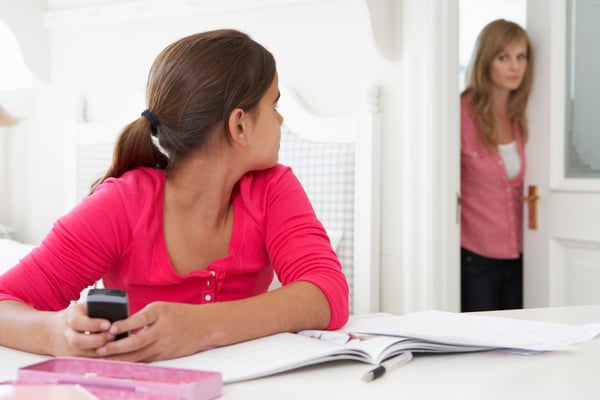5 min read
Parenting Good Digital Citizens
By: Nicole Thompson and Todd Halfast on Oct 11, 2019 8:40:10 AM

Have you ever been to a big city with your children? If so, what steps did you take to ensure their safety? You may have held their hands or made them stand close to you. You likely had your eyes on them at all times.
Your actions prevented them from being swallowed in a sea of busy pedestrians and shielded them from imminent danger. It’s unlikely that you let your children wander alone or had them meet you hours later.
Now, let’s pretend that big, unfamiliar city is the Internet. Are you still holding your children’s hands, or have you let them go and navigate the terrain alone? Dangerous people are still out there, even if you can’t see them face to face.
Helping your child become a good digital citizen is huge part of modern parenting. Kids are more likely to be online than they are to finish their veggies. The problem is many of today’s parents didn’t grow up with technology, let alone with guidance on how to use it.
Today, we’re diving into all things digital to help you understand how to keep your kids safe on social media.
Digital Footprints
A digital footprint is a record of data traced as you use the Internet; your digital footprint is your unique online identity, and your kids have one, too. Digital footprints are broken into two types.
Passive Footprints
Passive footprints are recorded without your knowledge. If you have ever done a Google search and wondered why Facebook almost immediately shows you ads for what you’ve just searched, you can thank passive footprints. The data from your browsing search impacts the ads you see on social media without your request.
Active Footprints
Active footprints are recorded when you perform actions on social media. Every post, check-in, tweet, retweet, comment, like, and share becomes an active digital trace.

Promoting Positive Digital Footprints
Social media has many benefits. Children can connect with friends or family who live or have moved out of town. Older children can network and advocate for causes about which they are passionate. Students can share their creative talents, engage with people from various cultural backgrounds, and share exciting news with a mass audience in a few clicks.
It’s important to remember that what your children choose to share on social media impacts their digital footprint and can make it easy to find their information.
Many colleges and employers review prospective students and job applicants by performing Internet searches and examining social media posts. Therefore, what your kids share on social is oftentimes a first impression to schools and businesses.
To make social media a positive experience, make sure you are setting your children up for success.
Set rules and guidelines for children using technology.
This may seem like a no-brainer, but children as young as two who use apps need to know which apps are for them and which ones are off limits. Establishing healthy boundaries early will help your children use technology wisely.
Consider purchasing “family devices” versus giving cellphones or tablets directly to children as their own. If purchasing a separate device is not an option, many devices allow you to setup parental controls and a “kid’s domain” with apps and games catered specifically for them.
Monitor your children’s social media behavior.
If you aren’t already, consider following and monitoring all of your children’s social media accounts. Have a discussion with your children about your level of involvement. Explain that your access is not only about establishing trust, but it is also to protect them from cyberbullies and other digital predators.
Remind them that this doesn’t mean you need to access their accounts and make or delete posts on their behalf. You can always ease your involvement as your children grow and prove their grasp on Internet etiquette.

Check and set privacy settings often.
Social media privacy policies change often. What was set to private last year may no longer be private. Consider making all social media accounts within your household private versus public.
What people post on the Internet is there—forever. Even if a post or picture is deleted, the content will still exist in the endless Internet cloud. Remember that all your children’s activity on the Internet contributes to their digital footprint.
Build a digital repertoire.
Help your children understand that social media can be more than just online interactions with friends. Encourage them to post about volunteer work, special achievements, and acts of kindness toward friends, family, and neighbors. Suggest that they create an album dedicated to their accomplishments.
Explain the benefits of showing the world the “real you” while conducting yourself with integrity and treating others with dignity and respect.
Before your children post on social media, or any Internet platform, encourage them to consider the following questions.
![]() What would my mother/father/grandparents/teacher think if they saw this post?
What would my mother/father/grandparents/teacher think if they saw this post?
![]() Do I want my family, friends, school, employer, or other authority figures to know about this?
Do I want my family, friends, school, employer, or other authority figures to know about this?
![]() Could this post lead to disciplinary action in school, at my job, or by law enforcement?
Could this post lead to disciplinary action in school, at my job, or by law enforcement?
Mistakes happen.
Mistakes can and do happen online. Kids will inevitably post something they shouldn’t. It’s part of the learning process. Be sure that your children know the best way to manage a mistake is to delete the post immediately.
Your involvement and guidance on social media use will help your child create positive digital footprints that will lead to appropriate interactions and a profile of success.
Please share your thoughts on this subject or recommendations with our community in the comments section below.
 Nicole Thompson is a contributing writer and editor to the Lincoln Learning blog. She brings more than a decade of experience in education, curriculum, and communications to her blogs. She has a Bachelor of Arts in Communications and a Master of Science in Instructional Leadership, with certifications in secondary English and Communications. Nicole is married with four children and has a spunky golden retriever named Cinder and a rescue dog named Annie Banannie.
Nicole Thompson is a contributing writer and editor to the Lincoln Learning blog. She brings more than a decade of experience in education, curriculum, and communications to her blogs. She has a Bachelor of Arts in Communications and a Master of Science in Instructional Leadership, with certifications in secondary English and Communications. Nicole is married with four children and has a spunky golden retriever named Cinder and a rescue dog named Annie Banannie.
 Todd Halfast is the Manager of Special Projects for Information Technology at Lincoln Learning Solutions and has been with the company for more than 8 years. Todd is an alumnus of the University of Pittsburgh. He enjoys spending his free time with his girlfriend, Lori, and her children. He is also a staunch supporter of the Pittsburgh Steelers and Penguins and is heavily involved in local youth hockey.
Todd Halfast is the Manager of Special Projects for Information Technology at Lincoln Learning Solutions and has been with the company for more than 8 years. Todd is an alumnus of the University of Pittsburgh. He enjoys spending his free time with his girlfriend, Lori, and her children. He is also a staunch supporter of the Pittsburgh Steelers and Penguins and is heavily involved in local youth hockey.
Related Posts
Online Art Education: Overcoming the Hurdles Part 1
The COVID-19 pandemic has shaken education dramatically. Students and teachers alike are now...
Online Art Education: Overcoming the Hurdles Part 2
As we continue our series on addressing the challenges brick-and-mortar art teachers face in the...
Promote Student Success Using LMS Data
As an online teacher, you likely have access to a plethora of data within your learning management...

